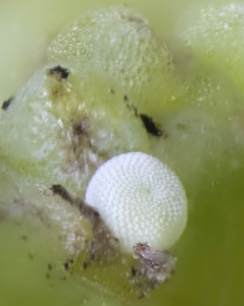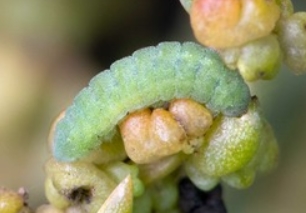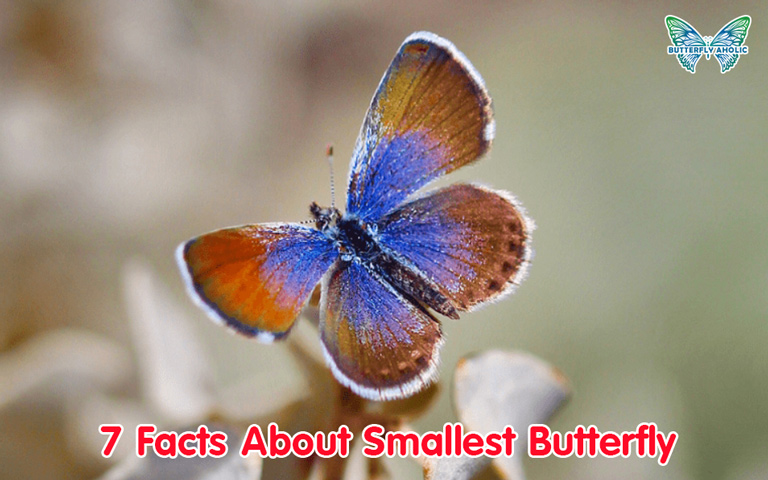7 Facts About The Smallest Butterfly In The World
With its wingspan (meaning the distance between the ends of each wing when stretched to its limits) being only 1.3 centimeters (a little bit less than ½ inches), the Western Pygmy Blue is the smallest butterfly in the world that has been discovered so far.
The measurement was provided by biologist Katy Prudic of the Oregon State University and included in National Geographic’s database.
Ms. Prudic also shared that she had located their range from mid-California to West America and deep into the territory of Venezuela.
More About Western Pygmy Blue, The World’s Tiniest Butterfly
- Common name: Western Pygmy Blue
- Scientific name: Brephidium exilis (Boisduval 1852)
- Wing span: 1/2 – 3/4 inch (1.2 – 2cm)
- Adult food: Flower nectar
Their appearance
If you observe this butterfly from the upper side, you will find a brown shade of copper taking up most of the area. The base of their wings has a rather dull and dark blue hue, while the hindwing’s underside has the same brown with white spots around the basal area.
Despite the general size, there is a minor difference between the genders. Male Western Pygmy Blue individuals tend to be smaller than the females, and the base of their upperside has a more visible iridescence of blue-violet.


When we look at the outer margin more carefully, we can recognize black spots arranged in a row and near the base, drawing prominent patterns on the fragile wings.
In a more poetic look, the transition from blue to copper brown then black and white makes me feel like the body of the butterfly is spreading a glow to its surroundings.
Love butterflies, check now: Butterfly Shoes & Butterfly Necklace
Their habitat
This tiny butterfly is more inclined to areas with alkaline properties such as salt marshes or deserts – mainly barren places.
The small size makes them more difficult to find, although you will have a better chance of spotting them if you look into their range in nature.
You might want to start from the Southwest of America, going from West Texas to California eastwards or Venezuela to Mexico.
When the weather becomes unfavorable, Western Pygmy Blue can also migrate to regions such as Oregon, Nebraska, or Arkansas, covering Bahrain, East Saudi Arabia, and the United Arab Emirates, where the living conditions are much better at this time of the year.
Recently, scientists observed the colonization of Western Pygma Blue in Tampa Bay, Florida. This behavior expands their range instead of shrinking it like many other butterfly species.
Their host & nectar plant
These tiny butterflies reside on Pigweed, saltbush species, and many members of the goosefoot family. We often see butterfly eggs on the leaves, yet every other spot on a plant can be good for laying eggs.
After the eggs hatch, the caterpillars will naturally continue to live and grow on the host plant. Any part of the plant can serve as a foot for them until they become adults and move to another place.
Their flight
In the northern region, these tiny butterflies are only seen from July to September due to the lower temperatures here. Meanwhile, you can almost always find them on Texas’ south side.
More interestingly, Western Pygmy Blues tend to migrate to more favorable conditions, even though they fly very slowly and weakly.
During the cold season, they will enter a pupae state, which limits their activities and helps them get through winter.
Check more: Do Butterflies Sleep?
Their breeding
As the mating season approaches, the male butterflies will claim territory and search for receptive female individuals.
Female butterflies will lay eggs right on the host plant, specifically all parts of it but with a preference for the skyward sides of the leaves. Over time, the eggs will hatch into larvae, also known as caterpillars.
The caterpillars of Western Pygmy Blue butterflies can consume the host plant, any part of it usable as food for larvae.
In warmer regions like the southern part of Texas, the imagos (fully developed adult insects) appear throughout the year, while they only emerge during hot months (July – September) in northern areas.
The lifespan of Western Pygma Blue butterflies is roughly three weeks if the weather conditions support them, and this cycle will repeat itself all over again.
Their eggs, caterpillar, chrysalis
As expected from the tiniest butterfly, the eggs of this individual are also extremely small. Its diameter is only 0.5 millimeters and the surface texture is not visible to bare eyes. At 230x magnification, you can spot a fine pattern on it.

The larvae are yellow-green with a diaphanous feel.

Within about a week, it will grow into a chrysalis and its skill will be shed, the color gradually changes to a darker green with tiny tubercles.

In approximately 10 days, the adult butterfly will emerge in its full form.
Their subspecies
The Western Pigmy Blue has four subspecies:
- Brephidium exilis isophthalma in Cuba, Jamaica, Bahamas, and Hispaniola (1862, by Herrich-Schäffer)
- Brephidium exilis thompsoni at Grand Cayman (1943, by Carpenter & Lewis)
- Brephidium exilis yucateca at Yucatán peninsula (1970, by Clench)
- Brephidium exilis exilis in Arizona, California, Nevada, New Orleans – Florida, New Mexico, Texas, and Mexico
Conclusion
The Western Pygmy Blue butterflies have surprised everyone who heard about them for the first time. Since it is nearly impossible to catch them on a casual walk, consider yourself lucky if you encounter one!
Up close, they are truly charmers with lovely colors and patterns that might have been underestimated!


I get at my home, in Malaysia, a very small black butterfly. at least, it looks like a butterfly. About 4 mm in size. Could it be a different type of insect?